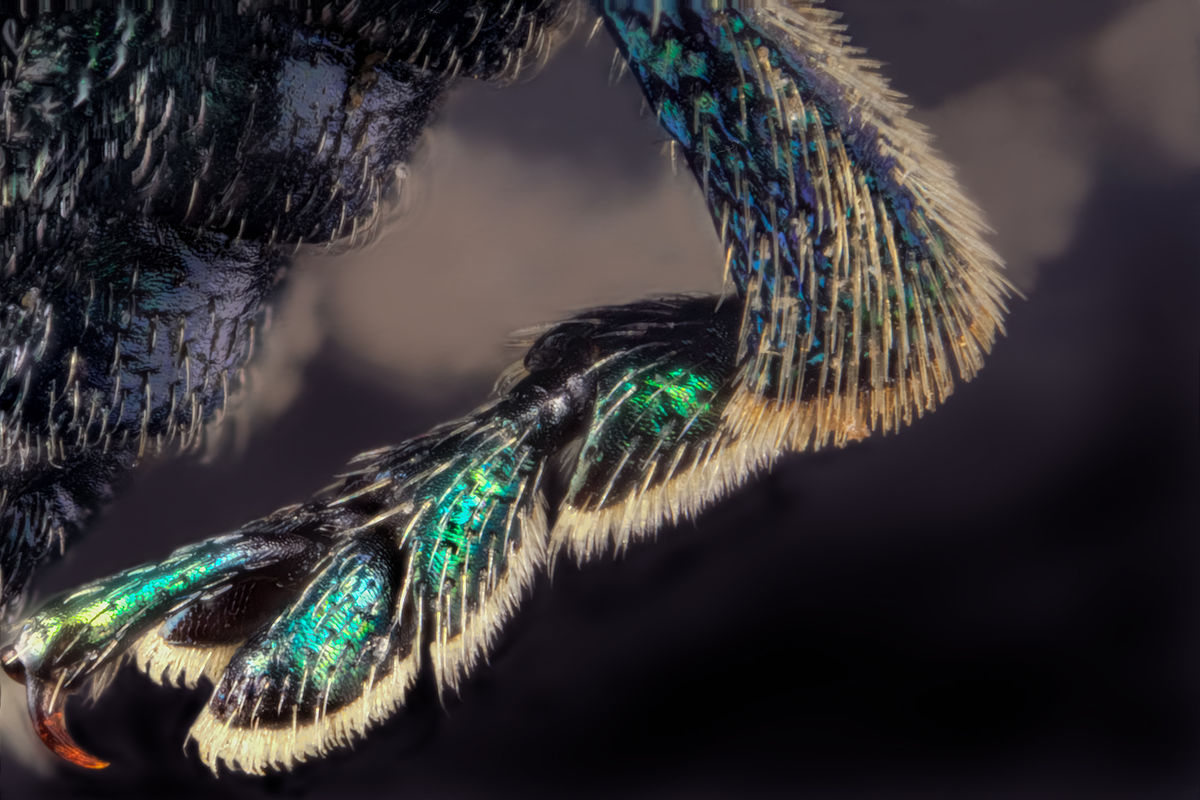Milkweed Beetle Foot
Feb 1, 2022 20:59:42 #
As a mechanical guy, I am always curious about how things work and I believe that Mother Nature is the ultimate mechanical designer.
This is a magnified view of a milkweed beetle's foot and for anyone who has ever wondered how an insect can walk vertically or upside down on a slick surface, including glass, this is how it works.
Some insects have pads on each of their tarsal segments, and some insects may have special adhesive pads on other segments of the leg. The pads typically contain numerous hairs (such as those of this milkweed beetle) that secrete an oily substance that causes the tips of the hairs to adhere to the surface. This substance provides traction and stickiness that allows insects to hold on to smooth surfaces of leaves and surfaces such as glass that they may land on. The ability to hold firmly to a slick surface is quite important in avoiding being carried away by a gust of wind.
Anyone who has ever tried to separate two wet dinner plates has witnessed the power of surface tension. Perhaps Mother Nature came up with the idea to aid her insects as she was washing her dishes. It's a possibility..!
This is a magnified view of a milkweed beetle's foot and for anyone who has ever wondered how an insect can walk vertically or upside down on a slick surface, including glass, this is how it works.
Some insects have pads on each of their tarsal segments, and some insects may have special adhesive pads on other segments of the leg. The pads typically contain numerous hairs (such as those of this milkweed beetle) that secrete an oily substance that causes the tips of the hairs to adhere to the surface. This substance provides traction and stickiness that allows insects to hold on to smooth surfaces of leaves and surfaces such as glass that they may land on. The ability to hold firmly to a slick surface is quite important in avoiding being carried away by a gust of wind.
Anyone who has ever tried to separate two wet dinner plates has witnessed the power of surface tension. Perhaps Mother Nature came up with the idea to aid her insects as she was washing her dishes. It's a possibility..!

Feb 1, 2022 21:01:42 #
That might be the neatest foot I have seen, at least for a long time. The colors are fantastic. Really well done.
Dennis
Dennis
Feb 1, 2022 23:28:01 #
dennis2146 wrote:
That might be the neatest foot I have seen, at least for a long time. The colors are fantastic. Really well done.
Dennis
Dennis
Thanks, Dennis. I appreciate your viewing and feedback.
Feb 2, 2022 06:23:16 #
sippyjug104 wrote:
As a mechanical guy, I am always curious about how... (show quote)
Fantastic image!!!
That's one mean looking claw!!!
Feb 2, 2022 08:12:28 #
Feb 2, 2022 10:34:00 #
Very good. I am sure someone has measured the mechanical strength of insect foot adhesive power. It may be similar to how gecko toes work, which rely on a fuzzy high surface area to provide adhesion thru what is known as van der Waals forces.
Feb 2, 2022 11:21:46 #
Manglesphoto wrote:
Fantastic image!!!
That's one mean looking claw!!!
That's one mean looking claw!!!
Thanks, Manglesphoto. We've got a winter storm coming our way so it will be a few good days to play inside.
Feb 2, 2022 11:22:14 #
ecobin wrote:
Great shot, Gary.
Thanks, Elliott. Glad that you could stop by.
Feb 2, 2022 11:28:53 #
Mark Sturtevant wrote:
Very good. I am sure someone has measured the mechanical strength of insect foot adhesive power. It may be similar to how gecko toes work, which rely on a fuzzy high surface area to provide adhesion thru what is known as van der Waals forces.
Thanks, Mark. Mother Nature is the ultimate mechanical engineer. She knows that the surface of each hair when in combination is by far easier to separate from the adhered surface than one large flat surface. The insect can break the surface tension allowing it to walk as hairs are pulled away a few at a time while others remain adhered and not get stuck like the two large flat dinner plates. Mother Nature is quite a gal..!
Feb 2, 2022 12:16:36 #
Feb 2, 2022 16:24:20 #
Feb 2, 2022 17:23:14 #
sippyjug104 wrote:
As a mechanical guy, I am always curious about how... (show quote)
Incredible photo and interesting explanation. Thanks for sharing!
If you want to reply, then register here. Registration is free and your account is created instantly, so you can post right away.








